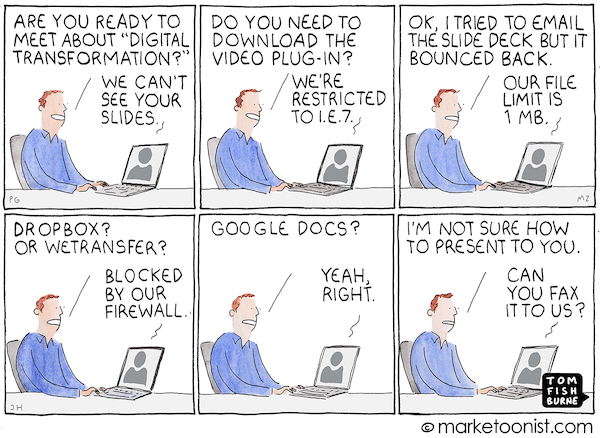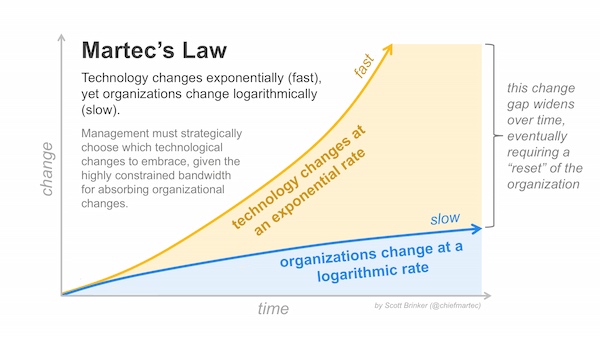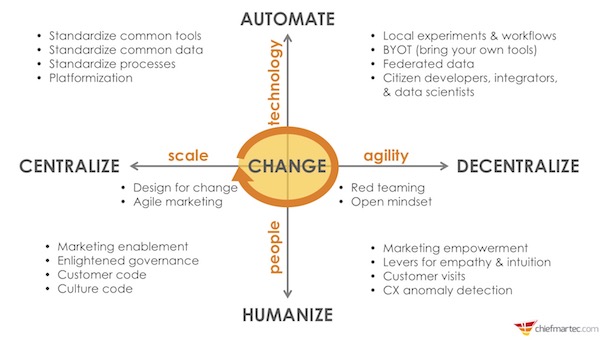I’m a huge fan of Tom Fishburne, a.k.a. Marketoonist. Every week, I look forward to his latest cartoon, pulling back the curtain on some absurdity of modern marketing that we all recognize but rarely call out. Tom artfully reveals the de-syncs between the dream and reality, in a way that’s funny and insightful.
You laugh, but he also helps you view marketing through a more pragmatic lens.
The above cartoon on “digital transformation” this past week was one of his best. Crikey, I can’t count how many times I’ve had some variation of that experience — almost always, ironically, in the context of trying to have a conference call about some new state-of-the-art technology. It’s like we’re planning a gourmet meal while still trying to figure out how to make fire.
From the 400+ of you who “liked” my share of his cartoon on Twitter — and the comments in reply — it’s clear that many of you could relate as well.
What I didn’t realize until later was that Tom referenced my post from 2013 on Martec’s Law — technology changes exponentially, organizations change logarithmically — in his write-up accompanying the cartoon. (I published an updated version of the post in 2016, Martec’s Law: The greatest management challenge of the 21st century.)
My first reaction was, “whoa, cool” — to be cited by someone whose work I admire so much is a nice surprise. The marketing geek in me enjoyed a moment of giddiness.
But as I thought about it, I also appreciated how brilliantly this cartoon captures the effects of Martec’s Law in the real world. I tend to get a little abstract in my writing — this case in point: technology changes exponentially, organizations change logarithmically — but Tom nailed a concrete example of this disparity.
The barriers that the protagonist in this cartoon is running into aren’t actually technical — they’re managerial. It’s management choices to limit file sizes, standardize on a single web client, block services at the firewall, forbid collaborative cloud apps, etc.
That’s not to say that those choices are completely arbitrary. Actually, you can make a case for each of them for reasons of security and control, reducing IT risk.
But these policies that are established with good intentions to minimize IT risk almost always have the side effect of creating a different kind of risk — business risk that the organization falls behind in its capabilities that new technologies are bringing to the market — and to their competitors and, most of all, to the expectations of their customers.
We need to manage IT risk. But we can’t ignore business risk either.
It’s not purely a Pareto trade-off. You can push the frontier of both, not unlike the balancing of centralization and decentralization — or automation and humanization — in The New Rules of Marketing Technology & Operations. But pushing both those frontiers forward together takes concentrated effort, multiple teams with different perspectives working to adapt their existing heuristics and mental models to a changing environment.
That takes time, and there’s only so much change that can be absorbed at once.
But before leaping off into the next “new thing” on the horizon, it’s important to evaluate just how much of the change required to harness previous innovations has been deeply absorbed. (Or not.)
In The 5 Forces of Marketing Technology & Operations grid, this is part of the “Humanize” bottom half of the spectrum. We’re not just looking to humanize experiences for customers. We also need to do the same for employees — through marketing enablement, enlightened governance, and marketing empowerment.
And it’s why managing change — the force at the center — is the most important mission of all for marketing technology and operations leaders.






Generally speaking, the smaller the business, the greater the gap between their current practise, and what could be called ‘leading edge practise’ as it relates to their digital operations.
This is a wider remit than just Martech, which although significant, and becoming more so, is still only a part of the digitisation of business.